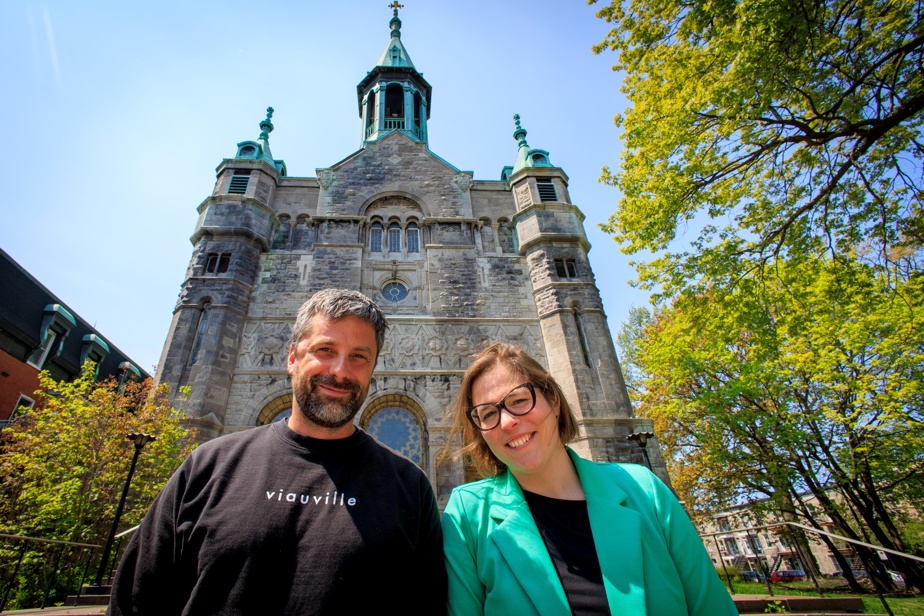There have been almost no masses since 2009 and the pandemic has put an end to the wrestling matches in his basement. The Casavant organ has been sold. The one we have already nicknamed “the Cathedral of the East” is not even heated in winter.
The Saint-Clément church in the Viauville district, in the Mercier–Hochelaga-Maisonneuve borough, has been practically abandoned for a decade, but residents have created an NPO to save it and give it a new vocation.
The name of their project: Station Viauville. “When I went to take my children to school, I witnessed the abandonment of the building every day,” says Marc-André Robertson. It’s a beautiful heritage street and I thought something had to be done. »
The father of the family has taken up residence in Viauville, more affordable than his former region of Rosemont. He was able to see the full potential of the neighborhood which marks the end of many long streets, including Ontario and Sainte-Catherine. “There are so many things to create here,” says the one who works in marketing.
Meanwhile, Marc-André Robertson learned that his father’s family came from the Viauville district. A father who ended his life when he was 5 years old. “I learned that his funeral took place here. »
A sign from God? At least the sign that the Saint-Clément church needed him to have a second life.
A grant
“When you arrive in Hochelaga, it’s as if you had no choice but to get involved,” says Émilie Therrien, who also carries the Station Viauville project at arm’s length.
The real estate and social economy lawyer founded the Regroupement des riparians de la rue Notre-Dame and the organization HocheLégal, which promotes access to justice.
-

PHOTO ALAIN ROBERGE, THE PRESS
A huge crack rises on the wall of the rood screen.
-

PHOTO ALAIN ROBERGE, THE PRESS
Phyllis Lambert was dazzled by the angels during her visit.
-

PHOTO ALAIN ROBERGE, THE PRESS
The cassocks still hanging in a closet
-

PHOTO ALAIN ROBERGE, THE PRESS
The anchor in the center aisle
-

PHOTO ALAIN ROBERGE, THE PRESS
There are all kinds of things…
-

PHOTO ALAIN ROBERGE, THE PRESS
…even Mass books on the ground surrounded by bird droppings.
-

PHOTO ALAIN ROBERGE, THE PRESS
There are six confessionals.
-

PHOTO ALAIN ROBERGE, THE PRESS
Time has stopped at the Saint-Clément church.
1/8
Last year, Marc-André Robertson and she formed a citizens’ committee which obtained a grant of $43,500 from the Ministry of Culture to analyze the state of the church (or rather its deterioration). As the money for the studies had to be advanced – and even a 25% down payment – the committee created the non-profit organization HocheLab. For a month, engineers and architects have been inspecting the church. “We should have the building’s health record at the end of June and that’s what will dictate what happens next,” says Marc-André Robertson.
An architectural gem
The church belongs to the Fabrique of the Saint-Nom-de-Jésus parish. From 2009 to 2019, there was only one mass per year. You have to see the cracks in the walls, the traces of water infiltration, the droppings of birds on the ground and even priests’ cassocks in the sacristy.

PHOTO ALAIN ROBERGE, THE PRESS
Marc-André Robertson and Emilie Therrien
You should also see the stained glass windows by Guido Nincheri (“the Michelangelo of Montreal”), the sumptuous columnless reinforced concrete vault by the architect Joseph Venne and the anchor reproduced on the floor of the central aisle in homage to the fact that the Catholic saint Clement of Rome was the patron saint of sailors (a nod to the nearby Port of Montreal).
When you walk in the Saint-Clément church, you feel like in an abandoned city scene, but one thing is clear: you can’t demolish it!
The Station Viauville project has significant support, that of architect Phyllis Lambert, founder of the Canadian Center for Architecture. With Dinu Bumbaru, from the Héritage Montréal organization, she visited the church twice, not to mention elected officials. “Phyllis Lambert was very familiar with the architectural particularities of the church,” emphasizes Marc-André Robertson. “It’s as if we had a validation that our claims are not in vain,” adds Émilie Therrien.
A four-part project
The Viauville district, which will highlight its 125e anniversary with festivities, has a wealth of heritage magnified by tall trees, but it lacks local shops. “There are glaring needs in the area and we could meet them,” argues Émilie Therrien.
We are in a food and sports desert.
Emilie Therrien
The team would like to be able to accommodate some of the 300 NPOs in the area, as well as preserve the spiritual aspect of the place.
The community of Viauville deserves a beautiful gathering place, argues Marc-André Robertson. “There have been a lot of issues recently in the district,” he underlines, citing the REM de l’Est and the Ray-Mont Logistiques transshipment site.
Over the past five years, 25 churches have turned to dust in Quebec. A quarter of the approximately 2,800 remaining places of worship are “changing”, to use the jargon of the Conseil du patrimoine religios du Québec (CPRQ). “But given the magnitude of the task, why are citizens the ones who have to mobilize? asks Emilie Therrien.
The question is launched.
Saint-Clément church in three dates
- 1899-1902 : Construction of the church (which will be enlarged later) according to the plans of the architect Joseph Venne.
- 1923: Installation of a Casavant organ which will be restored in 1985.
- 2009 : Closure of the church for worship (only one annual mass will then be pronounced there until 2019).
